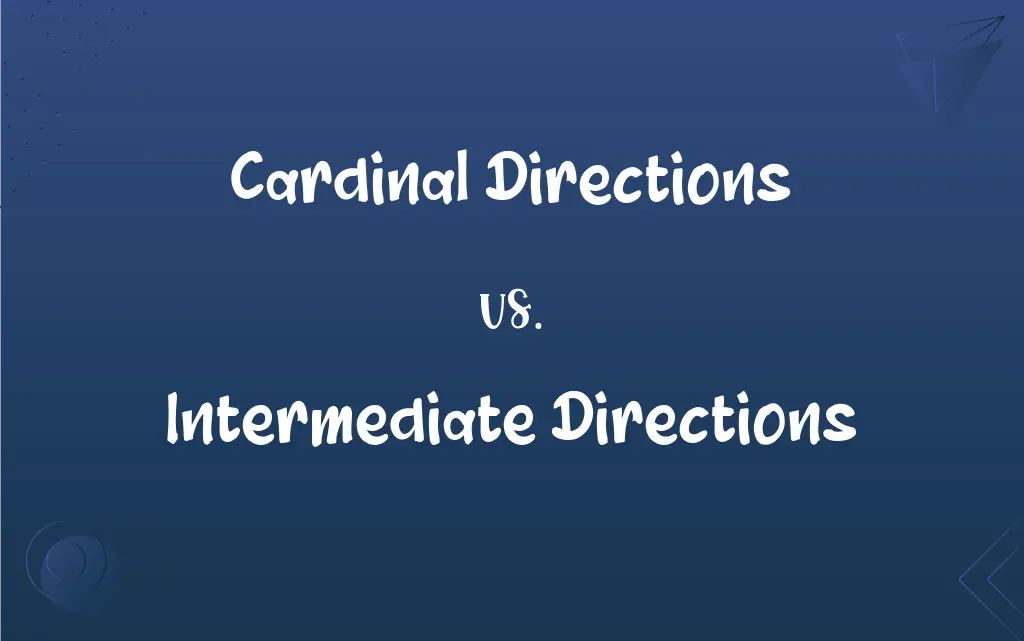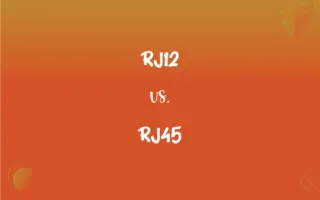Cardinal Directions vs. Intermediate Directions: What's the Difference?
Edited by Janet White || By Harlon Moss || Updated on October 8, 2023
Cardinal directions are the four main points of the compass: North, East, South, and West. Intermediate directions, also called intercardinal or ordinal directions, refer to Northeast, Southeast, Southwest, and Northwest.

Key Differences
Cardinal directions, constituting North, South, East, and West, serve as primary points of orientation on a compass or map. In contrast, intermediate directions refer to the points that fall midway between each pair of cardinal directions, namely, Northeast, Southeast, Southwest, and Northwest. Both sets of directions play integral roles in navigation, orienteering, and geographic descriptions, offering a framework to decipher and communicate location and movement in a spatial context.
Interestingly, cardinal directions are historically steeped in astronomical references, with each of the four main points corresponding to a particular astronomical phenomenon or time of day. Intermediate directions don’t possess the same historical or astronomical significance but augment the cardinal points by providing additional specificity in directional information, thereby facilitating more nuanced navigation.
Navigational activities, such as sailing and trekking, often incorporate the utility of cardinal directions to establish a basic framework for determining direction. Conversely, intermediate directions are essential when precise navigation is necessary, such as steering a course that isn’t directly aligned with any of the cardinal points, enriching our spatial understanding by interpolating between the principal directions.
When we observe weather patterns, wind directions, or ocean currents, the terminology of cardinal directions frequently surfaces, providing a simplified, generalized directional overview. On the other hand, intermediate directions become pivotal in describing more exact directional flows and transitions of such natural phenomena, offering a refined grid for better predicting and comprehending the movements and pathways involved.
For children and beginners in geography or navigation, understanding cardinal directions often becomes the starting point, establishing a primary directional matrix. Intermediate directions usually come into play as the learner becomes more adept and requires a more detailed directional lexicon to decipher and communicate more intricate spatial relationships and pathways in their navigational or geographic explorations.
ADVERTISEMENT
Comparison Chart
Basic Definition
Primary compass points: N, E, S, W.
Directions between cardinal points: NE, SE, SW, NW.
Quantity
Four
Four
Astronomical Relevance
Directly tied (e.g., sunrise in the East).
Not directly tied to astronomical events.
Usage Simplicity
Simpler and more general usage in navigation.
Used for more precise and nuanced navigation.
Educational Introduction
Usually introduced first in learning contexts.
Typically introduced after cardinal directions.
ADVERTISEMENT
Cardinal Directions and Intermediate Directions Definitions
Cardinal Directions
Cardinal directions provide a fundamental framework for geographical orientation.
Learning the cardinal directions is essential for basic geographical education.
Intermediate Directions
Intermediate directions do not correlate directly with significant astronomical phenomena.
Unlike cardinal directions, intermediate directions don’t correspond with phenomena like sunset or sunrise.
Cardinal Directions
Cardinal directions serve as the main axes on maps and compasses.
Maps typically display cardinal directions prominently to guide orientation.
Intermediate Directions
Intermediate directions are crucial for detailed map-reading and navigation in various contexts.
Intermediate directions on a map assist hikers in maintaining a precise course through terrain.
Cardinal Directions
Cardinal directions are utilized in diverse domains such as navigation, meteorology, and astronomy.
Meteorologists often describe wind patterns using cardinal directions.
Intermediate Directions
Intermediate directions lie between cardinal directions, encompassing Northeast, Southeast, Southwest, and Northwest.
To navigate more precisely, mariners utilize intermediate directions.
Cardinal Directions
Cardinal directions are the primary directional points North, South, East, and West.
The cardinal directions are foundational for basic navigation.
Intermediate Directions
Intermediate directions facilitate nuanced navigation and geographic descriptions.
Explorers in a forest might use intermediate directions to trace an exact path.
Cardinal Directions
Cardinal directions correlate with significant astronomical phenomena.
Sunrise correlates with the cardinal direction East.
Intermediate Directions
Intermediate directions are used to describe directions that aren’t aligned with cardinal points.
Traveling southeast allows one to navigate between south and east, adhering to intermediate directions.
FAQs
What are the cardinal directions?
The cardinal directions are the four main points on a compass: North, East, South, and West.
When are intermediate directions particularly useful?
Intermediate directions are useful for more precise navigation, especially when a route or direction isn't directly aligned with the cardinal points.
Do cardinal and intermediate directions cover all possible directions?
While they provide a basic framework, cardinal and intermediate directions do not encompass all possible directions, as direction can be expressed with varying degrees of precision.
Do navigation apps use cardinal and intermediate directions?
Yes, navigation apps utilize cardinal and intermediate directions to provide accurate and comprehendible route instructions.
How are cardinal directions represented on a map?
Cardinal directions are typically represented on a map with a compass rose, indicating North, East, South, and West.
Are intermediate directions always shown on maps?
Intermediate directions might be shown on a map’s compass rose, but this can depend on the map's level of detail and intended use.
Do all compasses display intermediate directions?
Some compasses, especially those used for detailed navigation, display intermediate directions, while simpler ones may only show cardinal points.
How are intermediate directions used in geology?
Geologists use intermediate directions to describe the orientation of geological features and to navigate within field sites.
How do cardinal directions relate to sun movements?
The sun rises roughly in the East and sets roughly in the West, providing a natural reference for the cardinal directions.
How are cardinal and intermediate directions used in meteorology?
Cardinal and intermediate directions are used in meteorology to describe wind directions, storm paths, and other weather phenomena.
Can children learn cardinal and intermediate directions easily?
Yes, children often begin by learning the cardinal directions, with intermediate directions introduced as they advance in understanding.
Is understanding cardinal and intermediate directions relevant in the age of technology?
While technology provides powerful navigational tools, a foundational understanding of cardinal and intermediate directions remains a valuable and applicable skill in various contexts.
Is the use of cardinal directions universal in all cultures?
While widespread, the emphasis and specifics of cardinal directions can vary among cultures, with some having more or fewer principal directions.
Can intermediate directions be derived using a basic compass?
Yes, by understanding the cardinal directions on a compass, one can infer intermediate directions between them.
How are intermediate directions defined?
Intermediate directions are the points that lie midway between each pair of cardinal directions: Northeast, Southeast, Southwest, and Northwest.
Are cardinal directions used in everyday navigation?
Yes, cardinal directions are commonly used in everyday navigation to provide a general sense of direction.
Is knowledge of intermediate directions necessary for casual travelers?
While casual travelers can often navigate successfully with cardinal directions, intermediate directions can enhance accuracy and specificity in travel.
Why are cardinal directions important in astronomy?
Cardinal directions are important in astronomy for orienting telescopes, identifying celestial objects, and navigating using stars.
How do intermediate directions enhance navigational capabilities?
Intermediate directions allow for more refined and detailed navigation, enabling pathways that aren't strictly aligned with cardinal points.
Can knowledge of cardinal directions aid in survival scenarios?
Absolutely, understanding cardinal directions can help individuals navigate and orient themselves in survival situations.
About Author
Written by
Harlon MossHarlon is a seasoned quality moderator and accomplished content writer for Difference Wiki. An alumnus of the prestigious University of California, he earned his degree in Computer Science. Leveraging his academic background, Harlon brings a meticulous and informed perspective to his work, ensuring content accuracy and excellence.
Edited by
Janet WhiteJanet White has been an esteemed writer and blogger for Difference Wiki. Holding a Master's degree in Science and Medical Journalism from the prestigious Boston University, she has consistently demonstrated her expertise and passion for her field. When she's not immersed in her work, Janet relishes her time exercising, delving into a good book, and cherishing moments with friends and family.






































































